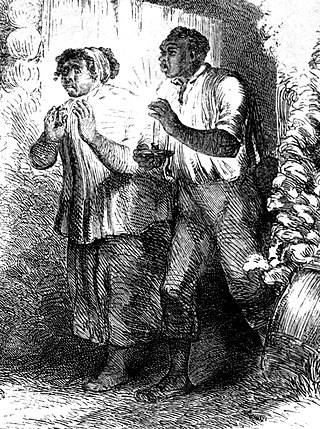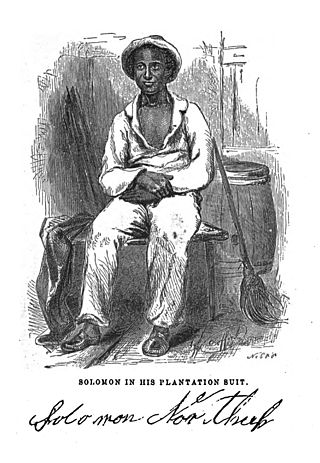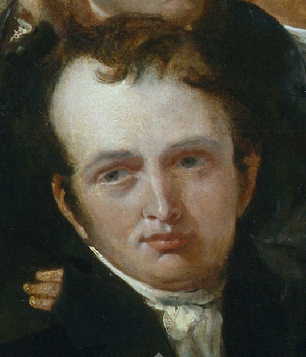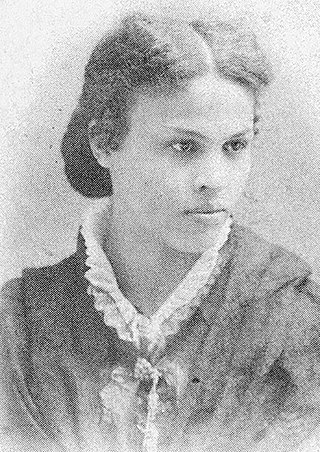Lewis Garrard Clarke | |
|---|---|
 | |
| Born | 1812 or 1815 |
| Died | December 16, 1897 |
Lewis Garrard Clarke was an ex-slave who published his experiences in his work, Narrative of the Sufferings of Lewis Clarke.
Lewis Garrard Clarke | |
|---|---|
 | |
| Born | 1812 or 1815 |
| Died | December 16, 1897 |
Lewis Garrard Clarke was an ex-slave who published his experiences in his work, Narrative of the Sufferings of Lewis Clarke.
Lewis Clarke was born in Madison County, Kentucky, seven miles from Richmond, in 1812. Depending on the source, Clarke's birth year is listed as 1812 or 1815. He is best known for his slave narrative, Narrative of the Sufferings of Lewis Clarke, During a Captivity of More Than Twenty-Five Years, Among the Algerines of Kentucky, One of the So Called Christian States of North America, dictated by himself.
In the beginning of his narrative, Clarke expounds upon his slave and plantation-owning grandfather, Samuel Campbell. Campbell raped a female slave named Mary who, according to Clarke, was half white. They had one daughter, Letitia Campbell before Campbell married. Clarke's father, Daniel Clarke, was a Scottish weaver who came to America for the American Revolution. He had married once before but his wife died and left him two sons. He fought as a Minuteman at the Battle of Bunker Hill and remained active until the end of the war effort. Campbell promised Clarke's father that Letitia would be free in his will, and with this promise, Clarke's father married her around 1800. [1]
Clarke's father died when Clarke was either 10 or 12 years old after receiving a devastating wound leaving him disabled, possibly paralyzed. Even when promised freedom, Letitia did not receive it and stayed enslaved as Clarke claims Campbell's heirs destroyed the will. During this time, Clarke fell into the hands of his grandfather's children, being the property of William and Betsy Benson, who treated him brutally. After Clarke learned he would be sold in New Orleans, Clarke fled to Ohio and across Lake Erie into Canada in 1841. [2] On arriving in Canada:
When I stepped ashore here, I said, sure enough I am free. Good heaven! what a sensation, when it first visits the bosom of a full grown man — one, born to bondage — one, who had been taught from early infancy, that this was his inevitable lot for life.
He published Narrative of the Sufferings of Lewis Clarke in 1845, and in 1846 an extended edition which included the experiences of his brother Milton. He also traveled about giving lectures on his experiences as a slave. It was during one of these trips that he met Harriet Beecher Stowe, who was so impressed by Clarke and his story that she would base the character George Harris in her novel Uncle Tom's Cabin on Clarke. [3]
While Clarke was not traveling, he lived in Warren County, Pennsylvania, before moving over the New York border to the town of Busti, New York. On 12 June 1849 he was married by Rev. L. P. Judson to Catherine Storum, but she died in April 1850. In the 1850 U.S. census he is listed living on the farm of William Storum, father of his recently deceased wife and also father-in-law of African-American abolitionist Jermain Wesley Loguen. [4] After the end of the Civil War, Clarke returned South and died on December 16, 1897, in Lexington, Kentucky where he was a member of Historic St Paul AME Church. His body lay in state at the Kentucky State Capitol on order of Governor William Bradley, and he was subsequently buried in Westwood Cemetery in Oberlin, Ohio.
1854 June 17–18 Sugar Grove Convention, Sugar Grove, Pennsylvania. Lewis Clarke, Rev. Jermain W. Loguen and Frederick Douglass [5]
The slave narrative is a type of literary genre involving the (written) autobiographical accounts of enslaved persons, particularly Africans enslaved in the Americas, though many other examples exist. Over six thousand such narratives are estimated to exist; about 150 narratives were published as separate books or pamphlets. In the United States during the Great Depression (1930s), more than 2,300 additional oral histories on life during slavery were collected by writers sponsored and published by the Works Progress Administration, a New Deal program. Most of the 26 audio-recorded interviews are held by the Library of Congress.

Uncle Tom is the title character of Harriet Beecher Stowe's 1852 novel Uncle Tom's Cabin. The character was seen by many readers as a ground-breaking humanistic portrayal of a slave, one who uses nonresistance and gives his life to protect others who have escaped from slavery. However, the character also came to be seen as inexplicably kind to white slaveholders, especially based on his portrayal in pro-compassion dramatizations. This led to the use of Uncle Tom – sometimes shortened to just a Tom – as a derogatory epithet for an exceedingly subservient person or house negro, particularly one aware of his or her own lower-class racial status.

Uncle Tom's Cabin; or, Life Among the Lowly is an anti-slavery novel by American author Harriet Beecher Stowe. Published in two volumes in 1852, the novel had a profound effect on attitudes toward African Americans and slavery in the U.S., and is said to have "helped lay the groundwork for the [American] Civil War".

Harriet Elisabeth Beecher Stowe was an American author and abolitionist. She came from the religious Beecher family and wrote the popular novel Uncle Tom's Cabin (1852), which depicts the harsh conditions experienced by enslaved African Americans. The book reached an audience of millions as a novel and play, and became influential in the United States and in Great Britain, energizing anti-slavery forces in the American North, while provoking widespread anger in the South. Stowe wrote 30 books, including novels, three travel memoirs, and collections of articles and letters. She was influential both for her writings as well as for her public stances and debates on social issues of the day.

Incidents in the Life of a Slave Girl, written by herself is an autobiography by Harriet Jacobs, a mother and fugitive slave, published in 1861 by L. Maria Child, who edited the book for its author. Jacobs used the pseudonym Linda Brent. The book documents Jacobs's life as a slave and how she gained freedom for herself and for her children. Jacobs contributed to the genre of slave narrative by using the techniques of sentimental novels "to address race and gender issues." She explores the struggles and sexual abuse that female slaves faced as well as their efforts to practice motherhood and protect their children when their children might be sold away.

Narrative of the Life of Frederick Douglass is an 1845 memoir and treatise on abolition written by African-American orator and former slave Frederick Douglass during his time in Lynn, Massachusetts. It is generally held to be the most famous of a number of narratives written by former slaves during the same period. In factual detail, the text describes the events of his life and is considered to be one of the most influential pieces of literature to fuel the abolitionist movement of the early 19th century in the United States.

John Rankin was an American Presbyterian minister, educator and abolitionist. Upon moving to Ripley, Ohio, in 1822, he became known as one of Ohio's first and most active "conductors" on the Underground Railroad. Prominent pre-Civil War abolitionists William Lloyd Garrison, Theodore Weld, Henry Ward Beecher, and Harriet Beecher Stowe were influenced by Rankin's writings and work in the anti-slavery movement.

Rev. Jermain Wesley Loguen, born Jarm Logue, in slavery, was an African-American abolitionist and bishop of the African Methodist Episcopal Zion Church, and an author of a slave narrative.

The North Star was a nineteenth-century anti-slavery newspaper published from the Talman Building in Rochester, New York, by abolitionist Frederick Douglass. The paper commenced publication on December 3, 1847, and ceased as The North Star in June 1851, when it merged with Gerrit Smith's Liberty Party Paper to form Frederick Douglass' Paper. At the time of the Civil War, it was Douglass' Monthly.

Henry Walton Bibb, was an American author and abolitionist who was born into slavery. Bibb told his life story in his Narrative of the Life and Adventures of Henry Bibb, An American Slave, which included many failed escape attempts followed finally by success when he escaped to Detroit. After leaving Detroit to move to Canada with his family, due to issues with the legality of his assistance in the Underground Railroad, he founded the abolitionist newspaper, Voice of the Fugitive. He lived in Canada until his death.

Twelve Years a Slave is an 1853 memoir and slave narrative by Solomon Northup as told to and written by David Wilson. Northup, a black man who was born free in New York state, details himself being tricked to go to Washington, D.C., where he was kidnapped and sold into slavery in the Deep South. He was in bondage for 12 years in Louisiana before he was able to secretly get information to friends and family in New York, who in turn secured his release with the aid of the state. Northup's account provides extensive details on the slave markets in Washington, D.C., and New Orleans, and describes at length cotton and sugar cultivation and slave treatment on major plantations in Louisiana.

John Hill Wheeler (1806–1882) was an American attorney, politician, historian, planter and slaveowner. He served as North Carolina State Treasurer (1843–1845), and as United States Minister to Nicaragua (1855–1856).

George William Alexander (1802–1890) was an English financier and philanthropist. He was the founding treasurer of the British and Foreign Anti-Slavery Society in 1839. The American statesman Frederick Douglass said that he "has spent more than an American fortune in promoting the anti-slavery cause ..."
Thomas James (1804–1891) had been a slave who became an African Methodist Episcopal Zion minister, abolitionist, administrator and author. He was active in New York and Massachusetts with abolitionists, and served with the American Missionary Association and the Union Army during the American Civil War to supervise the contraband camp in Louisville, Kentucky. After the war, he held national offices in the AME Church and was a missionary to black churches in Ohio. While in Massachusetts, he challenged the railroad's custom of forcing blacks into second-class carriages and won a reversal of the rule in the State Supreme Court. He wrote a short memoir published in 1886.

Slavery on the Barbary Coast refer to the enslavement of people taken captive by the barbary corsairs in the Barbary Coast area of North Africa.

Sarah Marinda Loguen Fraser, née Loguen, was an American physician and pediatrician. She was the fourth female African-American physician in the United States, and the first female doctor in the Dominican Republic.

Lewis Henry Douglass was an American military Sergeant Major, the oldest son of Frederick Douglass and his first wife Anna Murray Douglass.

The Fugitive Slave Convention was held in Cazenovia, New York, on August 21 and 22, 1850. It was a fugitive slave meeting, the biggest ever held in the United States. Madison County, New York, was the abolition headquarters of the country, because of philanthropist and activist Gerrit Smith, who lived in neighboring Peterboro, New York, and called the meeting "in behalf of the New York State Vigilance Committee." Hostile newspaper reports refer to the meeting as "Gerrit Smith's Convention". Nearly fifty fugitives attended—the largest gathering of fugitive slaves in the nation's history.
Barbara Ann Steward was a teacher, lecturer, abolitionist and advocate for industrial education African-Americans. She was the daughter of abolitionist Austin Steward.

Caroline Storum Loguen was an American abolitionist who helped to run a major depot on the Underground Railroad. Loguen helped an estimated 1,500 formerly enslaved persons reach freedom.
| Library resources about Lewis Clarke |
| By Lewis Clarke |
|---|
